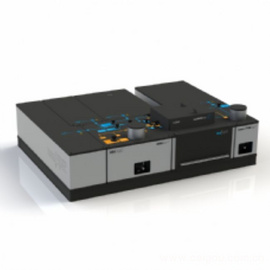

纳米傅里叶红外光谱仪nano-FTIR
------具有10nm空间分辨率的纳米红外光谱仪
neaspec公司的nano-FTIR技术
现代化学的一大科研难题是如何实现在纳米尺度下对材料进行无损化学成分鉴定。现有的一些高分辨成像技术,如电镜或扫描探针显微镜等,在一定程度上可以有限的解决这一问题,但是这些技术本身的化学敏感度太低,已经无法满足现代化学纳米分析的要求。而另一方面,红外光谱具有很高的化学敏感度,但是其空间分辨率却由于受到二分之一波长的衍射限限制,只能达到微米别,因此也无法进行纳米别的化学鉴定。
近期neaspec公司利用其的散射型近场光学技术发展出来的nano-FTIR纳米傅里叶红外光谱技术,使得纳米尺度化学鉴定和成像成为可能。这一技术综合了原子力显微镜的高空间分辨率,和傅里叶红外光谱的高化学敏感度,因此可以在纳米尺度下实现对几乎所有材料的化学分辨。因而,现代化学分析的纳米新时代从此开始。
neaspec公司的散射型近场技术通过干涉性探测针尖扫描样品表面时的反向散射光,同时得到近场信号的光强和相位信号。当使用宽波红外激光照射AFM针尖时,即可获得针尖下方10nm区域内的红外光谱,即nano-FTIR.
nano-FTIR 光谱与标准FTIR光谱高度吻合:
在不使用任何模型矫正的条件下,nano-FTIR傅里叶红外光谱仪获得的近场吸收光谱所体现的分子指纹特征与使用传统FTIR光谱仪获得的分子指纹特征吻合度高(如下图),这在基础研究和实际应用方面都具有重要意义,因为研究者可以将nano-FTIR光谱与已经广泛建立的传统FTIR光谱数据库中的数据进行对比,从而实现快速准确的进行纳米尺度下的材料化学分析。对化学成分的高敏感度与超高的空间分辨率的结合,使得nano-FTIR成为纳米分析的特工具。
应用案例:
nano-FTIR傅里叶红外光谱仪可以应用到对纳米尺度样品污染物的化学鉴定上。下图显示的Si表面覆盖PMMA薄膜的横截面AFM成像图,其中AFM相位图显示在Si片和PMMA薄膜的界面存在一个100nm尺寸的污染物,但是其化学成分无法从该图像中判断。而使用nano-FTIR在污染物中心获得的红外光谱清晰的揭示出了污染物的化学成分。通过对nano-FTIR获得的吸收谱线与标准FTIR数据库中谱线进行比对,可以确定污染物为PDMS颗粒。
nano-FTIR对纳米尺度污染物的化学鉴定
AFM表面形貌图像 (左), 在Si片基体(暗色区域B)与PMMA薄膜(A)之间可以观察到一个小的污染物。机械相位图像中(中),对比度变化证明该污染物的是有别于基体和薄膜的其他物质。将点A和B的nano-FTIR 吸收光谱(右),与标准红外光谱数据库对比, 获得各部分物质的化学成分信息. 每条谱线的采集时间为7min, 光谱分辨率为13 cm-1. ("Nano-FTIR absorption spectroscopy of molecular fingerprints at 20 nm spatial resolution.,”,F. Huth, A. Govyadinov, S. Amarie, W. Nuansing, F. Keilmann, R. Hillenbrand,)Nanoletters 12, p. 3973 (2012))
主要技术参数配置:
■ 反射式 AFM-针尖照明 ■ 标准光谱分辨率: 6.4/cm-1 ■ 保护的无背景探测技术 ■ 基于优化的傅里叶变换光谱仪 ■ 采集速率: Up to 3 spectra /s | ■ 高性能近场光谱显微优化的探测模块 ■ 可升光谱分辨率:3.2/cm-1 ■ 适合探测区间:可见,红外(0.5 – 20 μm) ■ 包括可更换分束器基座 ■ 适用于同步辐射红外光源 NEW!!! |
部分发表文章:
Science (2017)doi:10.1126/science.aan2735
Tuning quantum nonlocal effects in graphene plasmonics
Nature Nanotechnology (2017)doi:10.1038/nnano.2016.185
Acoustic terahertz graphene plasmons revealed by photocurrent nanoscopy
Nature Photonics (2017)doi:10.1038/nphoton.2017.65
Imaging exciton–polariton transport in MoSe2 waveguides
Nature Materials (2016)doi:10.1038/nnano.2016.185
Acoustic terahertz graphene plasmons revealed by photocurrent nanoscopy
Nature Materials (2016)doi:10.1038/nmat4755
Thermoelectric detection and imaging of propagating graphene plasmons
国内用户部分发表文章:
Nat. Commun.8, 15561(2017)
Imaging metal-like monoclinic phase stabilized by surface coordination effect in vanadium dioxide nanobeam
Adv. Mater. 29, 1606370 (2017)
The Light-Induced Field-Effect Solar Cell Concept –Perovskite Nanoparticle Coating Introduces Polarization Enhancing Silicon Cell Efficiency
Light- Sci & Appl 6, 204(2017)
Effects of edge on graphene plasmons as revealed by infrared nanoimaging
Light- Sci & Appl,中山大学accepted (2017)
Tailoring of electromagnetic field localizations by two-dimensional graphene nanostructures
Nanoscale9, 208 (2017)
Study of graphene plasmons in graphene–MoS2 heterostructures for optoelectronic integrated devices
Nano-Micro Lett.9,2 (2017)
Molybdenum Nanoscrews: A Novel Non-coinage-Metal Substrate for Surface-Enhanced Raman Scattering
J. Phys. D: Appl. Phys. 50, 094002 (2017)
High performance photodetector based on 2D CH3NH3PbI3 perovskite nanosheets
ACS Sens. 2, 386 (2017)
Flexible, Transparent, and Free-Standing Silicon Nanowire SERS
Platform for in Situ Food Inspection
Semiconductor Sci. and Tech.32,074003 (2017)
PbI2 platelets for inverted planar organolead Halide Perovskite solar cells via ultrasonic spray deposition
部分用户好评与列表(排名不分先后)
neaspec公司产品以其稳定的性能、高的空间分辨率和良好的用户体验,得到了国内外众多科学家的认可和肯定......
Prof. Dmitri Basov 美国 加州大学 University of California San Diego | "The neaSNOM microscope with it’s imaging and nano-FTIR mode is the most useful research instrument in years, bringing genuinely new insights." | |
Dr. Jaroslaw Syzdek 美国 劳伦斯伯克利实验室 Lawrence Berkeley National Laboratory | "We were looking for a flexible research tool capable of characterizing our energy storage materials at the nanoscale. neaSNOM proofed to be the system with the highest spatial resolution in infrared imaging and spectroscopy and brings us substantial new insights for our research” | |
陈焕君 教授 中山大学 Sun Yat-sen University | "The neaSNOM microscope boosted my research in plasmonic properties of noble metal nanocrystals, optical resonances of dielectric nanostructures, and plasmon polaritons of graphene-like two dimensional nanomaterials." | |
Prof. Rainer Hillenbrand Research Center Co-Founder and Scientific Advisor | "After many years of research and development in near-field microscopy, we finally made our dream come true to perform infrared imaging & spectroscopy at the nanoscale. With neaSNOM we can additionally realize Raman, fluorescence and non-linear nano-spectroscopy." | |
| Dr. Dangyuan Lei The Hong Kong Polytechnic University Department of Applied Physics Hong Kong | "We propose to establish a complete set of nano-FTIR and scattering-type SNOM in order to stay competitive in nanophotonics research as well as to maintain our state-of-the-art design and fabrication of novel nanomaterials. Only because of the unique technology from neaspec we were able to win this desirable university grant." | |
Prof. Dan Mittleman Brown University School of Engineering USA | "The neaSNOM near-field microscope and it’s user-friendly software offer us an incredible flexibility for the realization of our unique experiments – without compromises in robustness, handling and ease-of-use." | |
| Dr. Raul Freitas Centro Nacional de Pesquisa em Energia e Materiais (CNPEM) Laboratório Nacional de Luz Síncrotron (LNLS) Brazil | "The great stability and robustness of the neaSNOM are key features for serving our diverse user’s demands. The neaSCAN software is user-friendly and intuitive allowing fresh users to quickly start measuring." | |
| Prof. Dr. Rupert Huber University of Regensburg Department of Phyics Germany | "The unique dual beam-path design of the neaSNOM near-field microscope makes neaspec the natural choice for ultrafast spectroscopy at the nanoscale." |